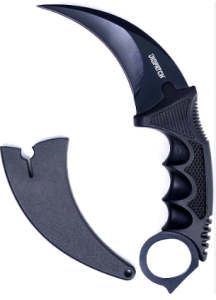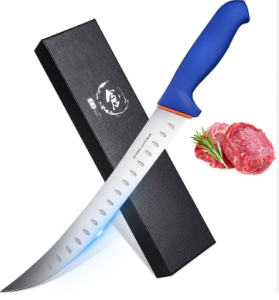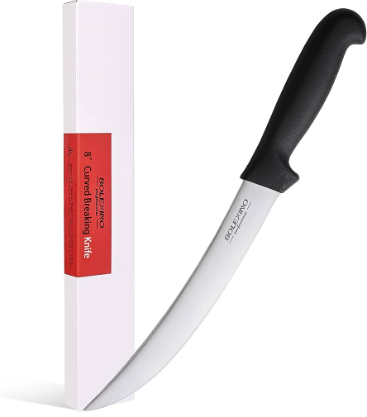Curved Knife
In the world of culinary craftsmanship, the tools a chef wields are extensions of their creative vision. Among these tools, the curved knife stands as a testament to the delicate artistry and precision that cooking demands. With its distinctive design and versatile functionality, the curved knife has earned its place as an indispensable instrument in the kitchen, enabling chefs to execute a wide array of culinary techniques with finesse and flair. In this exploration of the best curved knives, we delve into the intricacies that make these knives exceptional, their diverse uses, and the factors that set them apart.
The Essence of the Curved Knife:
At first glance, the curved knife captivates with its gracefully arched blade that flows seamlessly from the handle. This distinctive curve serves as the cornerstone of its functionality, providing chefs with a unique cutting edge that adapts to various tasks. Whether it’s the gentle rocking motion for precise mincing or the fluid slicing of proteins, the curvature of the blade enhances control and ease of movement.
The Pinnacle of Craftsmanship:
Crafting a truly exceptional curved knife demands an amalgamation of traditional artistry and modern precision. High-quality materials are paramount, as the blade’s composition dictates its sharpness, durability, and resistance to corrosion. Often, stainless steel alloys or Damascus steel are favored for their balance of strength and aesthetic appeal. The blade’s edge geometry must be honed to perfection, allowing for a razor-sharp edge that glides effortlessly through ingredients.
Versatility Redefined:
One of the key attributes that distinguish the best curved knives is their versatility. These knives excel across a spectrum of culinary tasks, showcasing their adaptability and prowess in the hands of both professional chefs and home cooks. From delicate tasks like deveining shrimp or trimming fat from cuts of meat to more intricate endeavors like intricate vegetable carvings, a well-designed curved knife is a multifunctional companion.
The Mastery of Technique:
The curved knife’s unique design lends itself to specific cutting techniques that elevate culinary creations. The rocking motion, facilitated by the blade’s curve, is perfect for mincing herbs and aromatics with unparalleled precision. Slicing becomes an art form, whether it’s producing translucent cuts of sashimi or expertly portioning a roast. The gentle curve of the blade allows for controlled, consistent cuts that enhance both presentation and taste.
Ergonomics and Aesthetics:
A knife is not only a tool but an extension of the chef’s hand. The best curved knives pay meticulous attention to ergonomics, ensuring a comfortable grip that reduces fatigue during prolonged use. The handle material, shape, and weight distribution are carefully designed to provide balance and maneuverability. Furthermore, aesthetics play a role in the overall experience – an exquisitely designed knife is a source of inspiration and pride in the kitchen.
Exploring Culinary Creativity:
Cooking is a dynamic realm where innovation and tradition converge. The curved knife, with its rich history and adaptability, encourages chefs to explore their creativity. Its unique shape invites experimentation, inspiring chefs to reimagine classic dishes and invent new ones. From elegantly carved garnishes to intricate vegetable designs that elevate plating to an art form, the curved knife is an essential tool for those who seek to push culinary boundaries.
Choosing Your Culinary Partner:
Selecting the best curved knife requires careful consideration. Factors such as blade length, handle design, and material should align with your culinary preferences. For professionals, a longer blade might be favored for its versatility, while home cooks might opt for a more compact option. Researching reputable brands and reading reviews can provide insights into the performance and longevity of a curved knife.
Choosing the Perfect Curved Knife: A Comprehensive Guide
A curved knife is a versatile tool that can be a game-changer in the kitchen, whether you’re a professional chef or a home cook. Its unique shape makes it ideal for tasks like slicing, chopping, and mincing with precision. However, selecting the best-curved knife can be a daunting task with the plethora of options available. This guide aims to provide you with essential tips and factors to consider when choosing the perfect curved knife for your culinary needs.

Purpose and Intended Use:
Before purchasing a curved knife, identify the primary tasks you’ll be using it for. Curved knives are great for tasks like slicing meats, chopping vegetables, and even delicate tasks like filleting fish. Understanding your specific use case will help you choose a knife with the right curvature, length, and features.
Blade Curvature:
The curvature of the blade significantly affects the knife’s functionality. A gentle curve is suitable for slicing and rocking motions, while a deeper curve is ideal for tasks requiring more leverage, like chopping. Consider the type of foods you often prepare to determine the level of curvature that suits your needs.
Blade Length:
The blade length of a curved knife can vary. Longer blades are better for tasks that require longer strokes, like slicing through larger cuts of meat. Shorter blades provide more control and are ideal for intricate tasks like peeling and detailed slicing.

Blade Material:
High-quality materials ensure durability and sharpness retention. Stainless steel is a common choice due to its resistance to corrosion and staining. High-carbon stainless steel offers a balance between sharpness and maintenance. Japanese knives often use high-carbon steel for superior edge retention, while German knives use stainless steel for ease of maintenance.
Handle Comfort and Design:
A comfortable handle is essential for extended use. Look for a handle that suits your grip style – whether it’s a pinch grip or full grip. Some handles have ergonomic designs that reduce fatigue during prolonged cutting sessions. Materials like wood, plastic, or composite materials are commonly used for handles. Choose one that feels secure and comfortable in your hand.
Balance and Weight:
A well-balanced knife is easier to control and reduces strain on your hand and wrist. Hold the knife in your hand and see if it feels balanced. The weight of the knife is also crucial; a knife that’s too heavy might be tiring to use, while one that’s too light might lack the necessary heft for efficient cutting.
Maintenance and Sharpening:
Consider the maintenance requirements of the knife. Some knives need more frequent sharpening than others. Research the sharpening process for the specific blade material and shape. Additionally, check if the manufacturer provides information on proper care and maintenance.
Brand and Reputation:
Opt for reputable brands with a history of producing high-quality knives. Research online reviews and seek recommendations from experienced chefs or cooks. Brands that focus on craftsmanship and quality materials are often more reliable choices.
Budget:
Set a realistic budget based on your needs and expectations. While it’s tempting to opt for the most expensive option, there are plenty of excellent curved knives available at various price points.
Try Before You Buy:
Whenever possible, visit a kitchen supply store and hold the knives in your hand. The way a knife feels in your hand is a personal preference, and physically handling the knife can help you make an informed decision.
In Conclusion:
The curved knife stands as a testament to the marriage of form and function in the culinary world. Its elegant curve is not just a visual delight, but a meticulously crafted tool that empowers chefs to achieve precision and artistry in their creations. From its versatile applications to its role in mastering various cutting techniques, the best curved knives are an essential companion for both professionals and passionate home cooks. As the culinary landscape continues to evolve, these knives remain timeless instruments of culinary excellence, embodying the essence of creativity and precision in every slice.
FAQs about the Best Curved Knife
What is a curved knife and how is it different from other types of knives?
A curved knife, also known as a curving knife or a curved blade knife, features a blade that is slightly arched or bent along its edge. This curvature allows for efficient rocking and slicing motions, making it particularly useful for tasks like chopping, mincing, and dicing. Unlike straight-edged knives, curved knives follow the natural motion of your hand and provide better control when working with ingredients.
What are the advantages of using a curved knife in the kitchen?
Curved knives offer several advantages in the kitchen. Their unique design enables effortless rocking motions, minimizing the need for excessive wrist movement. This results in reduced strain during repetitive cutting tasks, making them ergonomic and comfortable to use. Additionally, the curved blade improves the knife’s efficiency for precise cuts, especially when preparing vegetables, herbs, and even certain types of meats.
What should I consider when looking for the best curved knife?
When searching for the best curved knife, consider factors such as the quality of the blade material, handle comfort and grip, blade curvature, and overall construction. Look for a knife made from high-quality stainless steel or carbon steel for durability and sharpness retention. The handle should provide a comfortable grip to prevent slippage during use. Blade curvature should be balanced and suited to your preferred cutting techniques. Reading reviews and trying out different knives in person can help you determine which one feels best for your needs.
Which tasks is a curved knife best suited for?
A curved knife excels in various kitchen tasks, including chopping, mincing, and dicing. It’s particularly effective for tasks that involve a rocking or slicing motion, such as finely mincing herbs, garlic, or shallots. Its design is also advantageous for cutting through large vegetables, like bell peppers and cabbage, as well as for portioning and slicing cooked meats. The curved blade allows for a fluid motion, making it versatile for many culinary applications.
How do I care for and maintain the sharpness of my curved knife?
Proper care and maintenance are crucial to keeping your curved knife in optimal condition. To maintain its sharpness, use a honing rod regularly to realign the blade’s edge. When cleaning, hand wash the knife with mild soap and warm water, then promptly dry it to prevent corrosion. Avoid using abrasive scrubbers or placing it in a dishwasher, as this can damage the blade and handle. Store your curved knife in a knife block or magnetic strip to protect the edge and prevent accidents. For long-term maintenance, consider professional sharpening services to restore the blade’s edge when needed.
